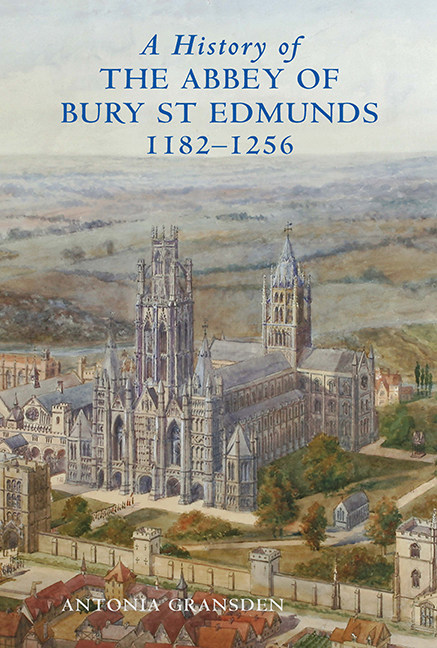Book contents
- Frontmatter
- Dedication
- Contents
- List of plates
- List of figures
- Preface
- Editorial Note
- Epigraph
- Acknowledgements
- Maps and plans (figures 1–9)
- Part I Samson of Tottington, Abbot 1182–1211
- 1 Samson's biographer, Jocelin of Brackland (de Brakelond), and his work
- 2 Samson's early life and career
- 3 Samson's election to the abbacy
- 4 The early years of Samson's abbacy and reform of estate management
- 5 Conflict with the convent
- 6 Relations with the town of Bury St Edmunds
- 7 Samson and secular law
- 8 Samson and the knights of St Edmund
- 9 Relations with the Angevin kings
- 10 Samson and the papacy
- 11 Samson as a builder
- 12 Religious and intellectual life under Samson
- 13 Samson's death and burial
- PART II The Abbey 1212–1256
- APPENDICES
13 - Samson's death and burial
from Part I - Samson of Tottington, Abbot 1182–1211
Published online by Cambridge University Press: 29 April 2017
- Frontmatter
- Dedication
- Contents
- List of plates
- List of figures
- Preface
- Editorial Note
- Epigraph
- Acknowledgements
- Maps and plans (figures 1–9)
- Part I Samson of Tottington, Abbot 1182–1211
- 1 Samson's biographer, Jocelin of Brackland (de Brakelond), and his work
- 2 Samson's early life and career
- 3 Samson's election to the abbacy
- 4 The early years of Samson's abbacy and reform of estate management
- 5 Conflict with the convent
- 6 Relations with the town of Bury St Edmunds
- 7 Samson and secular law
- 8 Samson and the knights of St Edmund
- 9 Relations with the Angevin kings
- 10 Samson and the papacy
- 11 Samson as a builder
- 12 Religious and intellectual life under Samson
- 13 Samson's death and burial
- PART II The Abbey 1212–1256
- APPENDICES
Summary
Abbot Samson died at St Edmunds on 30 December 1211. As England was still under an interdict, when no one could be buried in hallowed ground, he was buried in the cloister garth. The interdict was lifted on 2 July 1214 and the prior and some of the senior monks wanted to move Samson's body for re-burial in the abbey church, ‘for greater honour’. But at this time the monks were embroiled in a bitter controversy over the election to the abbacy of Hugh of Northwold. His chief opponent was the sacrist, Robert of Graveley, who himself aspired to be abbot and whose candidature was supported by a strong party of monks. Graveley immediately opposed the re-burial of Samson in the church, saying that ‘no one, however great his power, ought to be buried there’. Instead it was decided to bury him in the chapter-house where Ording and Hugh I had been buried. Graveley organized the whole proceedings which took place on 12 August in the prior's absence. Samson's coffin was disinterred early in the morning, ‘about the hour of matins’, and left resting on a tripod in the garth until evening. Then, while the monks were at vespers, he buried the body in the chapter-house in the presence of only one of the monks. Graveley hoped to gain credit for his expedition and efficiency.
Samson's reputation at St Edmunds was high at the time of his death and remained so at least until well into the fifteenth century. This is apparent from the obituary notice in the contemporary Annales Sancti Edmundi and the commemoration in the Benefactors’ List preserved in the Kitchener's register. The passages are worth quoting, because even though in laudatory style, they show what aspects of Samson's rule the monks prized most. The obituary notice in the Annales, freely translated, reads as follows:
On the sixth day after the Birth of the Lord Samson, of pious memory, the venerable abbot of St Edmunds, died at that place. He had ruled the abbey committed to him successfully for thirty years, less two months, and freed it from all kinds of debts and extended its very extensive privileges, liberties, possessions and buildings, and he had renewed religious observance both inside and outside [the abbey] very sufficiently.
- Type
- Chapter
- Information
- A History of the Abbey of Bury St Edmunds, 1182–1256Samson of Tottington to Edmund of Walpole, pp. 145 - 148Publisher: Boydell & BrewerPrint publication year: 2007



